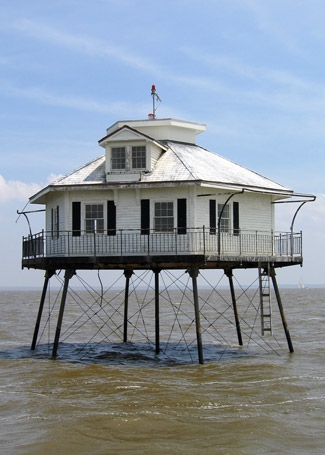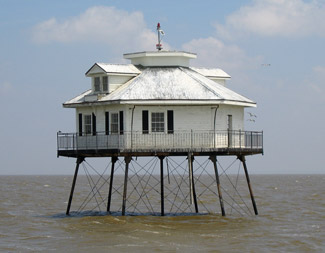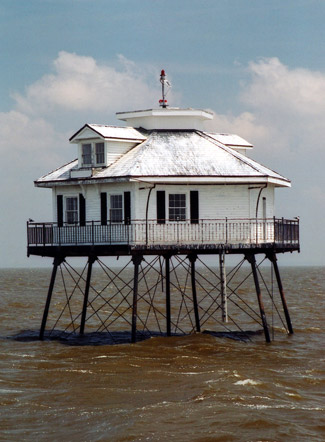| Mobile Bay, AL |

  |
Description:
Captain John Grant is rightly known as the
“Father of Gulf Coast Transportation”, and several of his
transportation projects are tightly coupled with Gulf Coast
lighthouses. At the age of twenty-five, Grant perfected a dredge
and used it from 1826 to 1829 to deepen the passes into the harbor
at Mobile. A year after the dredging, the Choctaw Lighthouse was
built to aid vessels that could now reach the port. Grant next
turned his talents to the construction of the railroad linking New
Orleans with Milneburg on Lake Pontchartain. Port Pontchartrain
was established at the railroad’s terminus in Milneburg, and
several lighthouses were subsequently constructed to improve
navigation into the port. Grant’s name is mostly closely
associated with his dredging in 1839 of a pass linking Mississippi
Sound with Mobile Bay. Known as Grant’s Pass, this channel made
it possible for ships to avoid entering the Gulf of Mexico, when
sailing between Mobile and New Orleans. Grant required toll
payments for use of his pass and eventually constructed a private
lighthouse at Tower Island to assist navigation along his
waterway.
Single handedly, Grant had greatly improved access to Mobile Bay and the port at Mobile, however, the twenty nine miles between these points were still hazard for mariners. Mobile Bay is quite shallow, and in the early 1800s the best shipping channel inside the bay was only marked by wooden stakes and copper-clad barrels. It wasn’t until a channel with a depth of 17 feet was dredged in the 1880s that large vessels could safely reach Mobile. This improvement prompted the construction of a lighthouse at the bend in the dogleg channel, which was located midway along the route. Given its location in roughly the center of the bay, the lighthouse is known as both Middle Bay Lighthouse and Mobile Bay Lighthouse. Due to high labor costs in the post-Civil-War South, the lighthouse was prefabricated in the North and then shipped to Mobile Point, where it arrived in 1885. The screwpile lighthouse consisted of a wooden hexagonal dwelling with a roof that slopped upwards to the centrally located lantern room. The lighthouse was supported by seven legs –one in the middle, and a single leg extending from each corner of the superstructure. After the piles had been screwed into the bottom of the bay, the structure suddenly settled seven and a half feet on September 12, 1885. Wooden piles were hurriedly driven around the screwpiles and succeeded in stabilizing the lighthouse. On December 1, 1885, the light from a fourth-order Fresnel lens first cast its beam from atop the lighthouse. After serving for just twenty years, the lens and lantern room were removed from the lighthouse, and two actelyne lights were mounted on a pole protruding from the roof. During World War I, the keeper responsible for the lights and his wife had a baby at the lighthouse. When the mother was unable to nurse the infant, the couple’s creativity was put to the test. Rather than send the mother and child ashore, a small coral was created on the lighthouse's gallery, and a milk cow was transported to the station. In 1935, the light was electrified. During the next several decades, no keepers were present to care for the lighthouses, and it fell into a state of disrepair. In 1967, the Coast Guard received permission from the General Services Administration to demolish the dilapidated lighthouse. Fortunately, several parties protested the decision. The Mobile Bar Pilots Association argued that the lighthouse still served a vital navigational role, as it was more readily picked up on ships' radars than the small, modern buoys. The pleas were convincing, and the lighthouse was spared. The Mobile Bay Lighthouse was placed on the National Register of Historic Places in 1975, helping to ensure its continued preservation. The Alabama Historical Commission assumed responsibility for the lighthouse, and as its 100th anniversary approached, the Middle Bay Light Centennial Commission was established to restore the lighthouse for a celebration. Decking was replaced, along with doors and windows, and the lighthouse received a fresh coat of paint. On December 1, 1985, yachts converged on the lighthouse to participate in the anniversary celebration. Like any exposed structure, the lighthouse is in need of periodic maintenance and refurbishing. By 2002, the lighthouse had deteriorated quite badly. In that year, major restoration work was accomplished by Thompson Engineering under a $349,400 contract form the Alabama Historical Commission. The lighthouse received a new slate roof, damaged wood and corroded tie rods were replaced, and the lighthouse was painted both inside and out. The roughly fifteen-foot-tall pyramidal structure that displayed a red flashing light atop the lighthouse was replaced by a six-foot pole supporting a solar powered red light. A Fresnel lens from the Mobile Bay Lighthouse is currently on loan to the Fort Morgan Museum, where it is on display along with the lens from the Sand Island Lighthouse. The note below the lens states that it was one of a pair of lenses that replaced the original fourth-order lens used in the lighthouse. Other sources claim the lens in the museum is the original lens. The lantern room from the Mobile Bay Lighthouse is in the possession of the Alabama Historical Commission and is undergoing restoration. Currently, the plan is to not return the lantern room to the lighthouse, but rather have it on display at fundraising events.
Location: Located near the middle of Mobile Bay, 14.3 miles north of Mobile Point. Latitude: 30.43745 Longitude: -88.01165 Travel Instructions: This lighthouse should be seen from the water.
|
